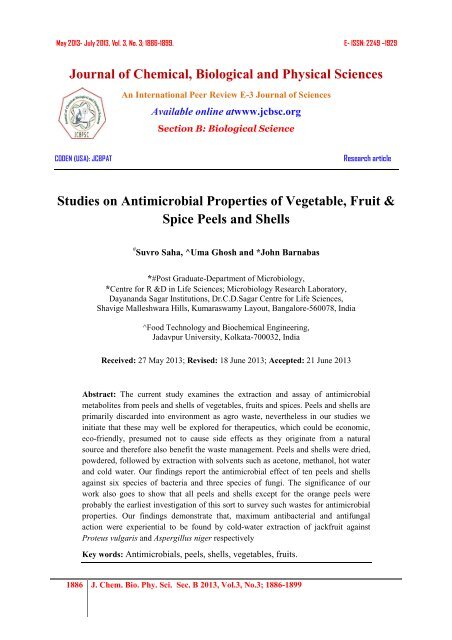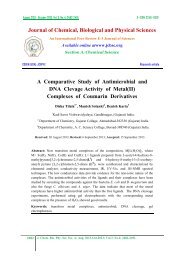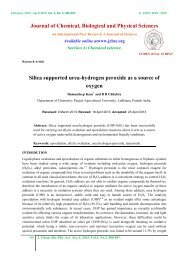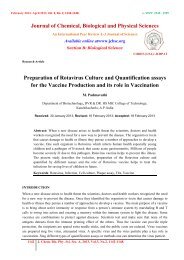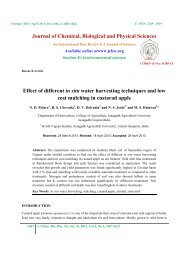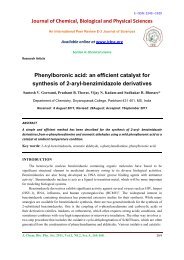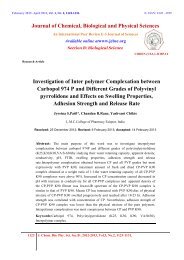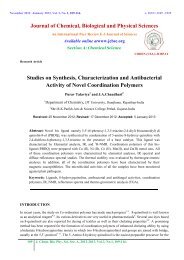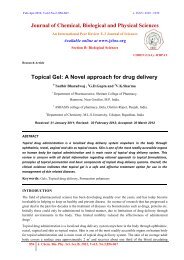Studies on Antimicrobial Properties of Vegetable, Fruit & Spice ...
Studies on Antimicrobial Properties of Vegetable, Fruit & Spice ...
Studies on Antimicrobial Properties of Vegetable, Fruit & Spice ...
- No tags were found...
Create successful ePaper yourself
Turn your PDF publications into a flip-book with our unique Google optimized e-Paper software.
May 2013- July 2013, Vol. 3, No. 3; 1886-1899. E- ISSN: 2249 –1929Journal <strong>of</strong> Chemical, Biological and Physical SciencesAn Internati<strong>on</strong>al Peer Review E-3 Journal <strong>of</strong> SciencesAvailable <strong>on</strong>line atwww.jcbsc.orgSecti<strong>on</strong> B: Biological ScienceCODEN (USA): JCBPATResearch article<str<strong>on</strong>g>Studies</str<strong>on</strong>g> <strong>on</strong> <strong>Antimicrobial</strong> <strong>Properties</strong> <strong>of</strong> <strong>Vegetable</strong>, <strong>Fruit</strong> &<strong>Spice</strong> Peels and Shells# Suvro Saha, ^Uma Ghosh and *John Barnabas*#Post Graduate-Department <strong>of</strong> Microbiology,*Centre for R &D in Life Sciences; Microbiology Research Laboratory,Dayananda Sagar Instituti<strong>on</strong>s, Dr.C.D.Sagar Centre for Life Sciences,Shavige Malleshwara Hills, Kumaraswamy Layout, Bangalore-560078, India^Food Technology and Biochemical Engineering,Jadavpur University, Kolkata-700032, IndiaReceived: 27 May 2013; Revised: 18 June 2013; Accepted: 21 June 2013Abstract: The current study examines the extracti<strong>on</strong> and assay <strong>of</strong> antimicrobialmetabolites from peels and shells <strong>of</strong> vegetables, fruits and spices. Peels and shells areprimarily discarded into envir<strong>on</strong>ment as agro waste, nevertheless in our studies weinitiate that these may well be explored for therapeutics, which could be ec<strong>on</strong>omic,eco-friendly, presumed not to cause side effects as they originate from a naturalsource and therefore also benefit the waste management. Peels and shells were dried,powdered, followed by extracti<strong>on</strong> with solvents such as acet<strong>on</strong>e, methanol, hot waterand cold water. Our findings report the antimicrobial effect <strong>of</strong> ten peels and shellsagainst six species <strong>of</strong> bacteria and three species <strong>of</strong> fungi. The significance <strong>of</strong> ourwork also goes to show that all peels and shells except for the orange peels wereprobably the earliest investigati<strong>on</strong> <strong>of</strong> this sort to survey such wastes for antimicrobialproperties. Our findings dem<strong>on</strong>strate that, maximum antibacterial and antifungalacti<strong>on</strong> were experiential to be found by cold-water extracti<strong>on</strong> <strong>of</strong> jackfruit againstProteus vulgaris and Aspergillus niger respectivelyKey words: <strong>Antimicrobial</strong>s, peels, shells, vegetables, fruits.1886 J. Chem. Bio. Phy. Sci. Sec. B 2013, Vol.3, No.3; 1886-1899
<str<strong>on</strong>g>Studies</str<strong>on</strong>g> <strong>on</strong>….INTRODUCTIONSuvro Saha et.al.The antibacterial properties <strong>of</strong> plant extracts have been a searing area for investigators <strong>of</strong>microbiology, pharmacology and related fields. Although there is a great sum <strong>of</strong> progress inc<strong>on</strong>taining infectious diseases and the development <strong>of</strong> new drugs, diseases caused by variouspathogenic microorganisms are still c<strong>on</strong>templated to be a major threat to public health 1 . Thesepathogens have become resistant to many traditi<strong>on</strong>ally used antimicrobial agents. In the past fewdecades it is observed that there is a dramatic increase in microbial resistance to antimicrobial agents,therefore this has led the scientific community to ascertain new antimicrobials and c<strong>on</strong>sequently t<strong>of</strong>ormulate new drugs. A global problem <strong>of</strong> mortality due to drug-resistant infecti<strong>on</strong>s and relatedillnesses is found <strong>on</strong> the rise at an alarming rate. An estimated twenty five thousand patients succumbto death as a result <strong>of</strong> antibiotic resistant in Europe each year and embody a cost <strong>of</strong> $1·85 billi<strong>on</strong> 3 andin the USA an estimated $20 billi<strong>on</strong> a year 4 al<strong>on</strong>e and so in the Asian countries and the other parts <strong>of</strong>the world. It is thought that the antimicrobial resistance is <strong>on</strong>e <strong>of</strong> the three greatest threats to humanhealth by The World Health Organizati<strong>on</strong>. The nosocomial infecti<strong>on</strong>s are thought to be more severeworldwide meritoriously escape the effects <strong>of</strong> ratified antibacterial drugs 5-7 . This nature <strong>of</strong> antibioticpipeline struggle may actually alter the exercise <strong>of</strong> medicine as it is known.It is comprehended that the operati<strong>on</strong>al life span <strong>of</strong> any antibiotic is limited, for this reas<strong>on</strong> there isgrowing interest <strong>of</strong> clinical microbiologists for antimicrobial plant extracts as these phytochemicalsmay find their way into the store <strong>of</strong> antimicrobial drugs recommended by physicians, several <strong>of</strong> whichhave already being tested <strong>on</strong> humans. It is exciting to note that, two or three antibiotics resulting frommicroorganisms are propelled each year 8 . Of late, the plant compounds their extracts are relishingboundless popularity and the sales <strong>of</strong> these medicines increase enormously. Factually, plants <strong>of</strong>fer anatural source <strong>of</strong> creativeness for novel drug compounds, as plant derived medicines have made hugeimpacts <strong>on</strong> human health and well-being. Over fifty percent <strong>of</strong> the western drugs are understood tohave derived from plant materials 9 moreover these antibiotics made from these sources have not beenfound to cause side effects and are also found to be less expensive 10,11.Peels and shells <strong>of</strong> vegetables, fruits and spices are discarded as garbage and a great amount <strong>of</strong> suchwastes are produced during industrial processing. Most <strong>of</strong> the time these wastes are utilized asbi<strong>of</strong>ertilizers but using this agro waste therapeutically is an innovative c<strong>on</strong>cept which is graduallygaining acceptance moreover, these are novel, natural, eco-friendly and biodegradable. These highlyec<strong>on</strong>omic sources for deriving antimicrobials, can be used in preventi<strong>on</strong> <strong>of</strong> diseases caused bypathogenic microbes. It was estimated that <strong>on</strong>ly citrus waste amount was to approximately 350,000t<strong>on</strong>s per year. This is probably a new alternative way <strong>of</strong> waste management. The current work focuses<strong>on</strong> the extracti<strong>on</strong> and assay <strong>of</strong> antimicrobial comp<strong>on</strong>ents from peels and shells <strong>of</strong> vegetables, fruitsand spices. Peels and shells: orange (Citrus sinensis) peels, st<strong>on</strong>e apple (Aeglem armelos) shells,coc<strong>on</strong>ut (Cocos nucifera) shells, pea (Pisum sativum) peels, jack fruit (Artocarpus heterophyllus)peels, Banana Inflorescence peel, pumpkin (Cucurbit apepol) peels, watermel<strong>on</strong> (Citrullus lanatus)peels, black cardamom (Amomum subulatum) peels, nutmeg (Myristica fragrans) shells. MicrobialCultures: Escherichia coli, Klebsiella pneum<strong>on</strong>ia, Staphylococcus aureus, Bacillus subtilis, Proteusvulgaris, Lactococcus lactis, Aspergillus niger, Candida albicans, Sporotrichum pruinosum.MATERIALS AND METHODSPlant Materials: Fresh samples <strong>of</strong> fruits, spices and nuts were obtained from industrial wastes. Theywere thoroughly washed with tap water. After air-drying, the peels were separated and cut into small1887 J. Chem. Bio. Phy. Sci. Sec. B; 2013, Vol.3, No.3; 1886-1899.
<str<strong>on</strong>g>Studies</str<strong>on</strong>g> <strong>on</strong>….Suvro Saha et.al.pieces. In case <strong>of</strong> coc<strong>on</strong>ut and st<strong>on</strong>e apple the shells were neatly shaven. Then these peels and shellswere set aside for drying in sunlight for 24 hours and shifted to an hot air oven at 40 0 CMicrobial Strains & Culture Preparati<strong>on</strong>:Bacterial Strains used: Staphylococcus aureus, Proteus vulgaris, Lactococcus lactis, Bacillussubtilis, Escherichia coli, Klebsiella pneum<strong>on</strong>ia.Fungal strains used: Sporotrichum pruinosum, Candida albicans and Aspergillus niger.The bacterial cultures were maintained <strong>on</strong> nutrient agar media (pH-7.0). They were sub-culturedweekly and subsequently stored at 4 0 C. The fungal cultures were maintained <strong>on</strong> Czapek Dox Agarmedia (pH-5.6) and they were sub-cultured weekly and subsequently stored at 4 0 C for another 24hours. After complete drying, peels and shells were subjected to homogenizati<strong>on</strong> to make finepowder. These powders were sealed in air tight bottles. They were then used for solvent extracti<strong>on</strong>.Extracti<strong>on</strong> Procedure: The dried powder <strong>of</strong> peels and shells were extracted individually by usingsolvents such as Acet<strong>on</strong>e, Methanol, Hot water & Cold Water. The powder and solvent were mixed in1:10 (Powder: Solvent) ratio in a c<strong>on</strong>ical flask and the flasks were plugged tightly. The temperaturefor the hot water extracti<strong>on</strong> and cold water extracti<strong>on</strong> were maintained at 50 0 C and room temperaturerespectively. After 24 hours, these extracts were centrifuged at 4000rpm for 5 minutes and thesupernatant was collected and this supernatant was subjected for lyophilizati<strong>on</strong> to evaporate thesolvent. Then the resulting dried crude extract was used in a c<strong>on</strong>centrati<strong>on</strong> <strong>of</strong> 3mg/ml by using sterilewater for antimicrobial susceptibility testing.Bacterial and Fungal Strains & Culture Preparati<strong>on</strong>: The bacterial strains used in the study wereStaphylococcus aureus, Proteus vulgaris, Lactococcus lactis, Bacillus subtilis, Escherichia coli,Klebsiella pneum<strong>on</strong>ia. The fungal strains were Sporotrichum pruinosum, Candida albicans andAspergillus niger.The bacterial cultures were maintained <strong>on</strong> nutrient agar media (pH7.0). They were sub-culturedweekly and subsequently stored at 4 0 C. The fungal cultures were preserved <strong>on</strong> Czapek Dox Agarmedia (pH 5.6) and were sub-cultured weekly and subsequently stored at 4 0 CANTIMICROBIAL ACTIVITY ASSAYThe antimicrobial activity <strong>of</strong> the obtained crude samples was performed by Agar Well Diffusi<strong>on</strong>method which is also known as Kirby Bauer or Cup Plate method.Antibacterial Activity: Sterile nutrient agar media was poured <strong>on</strong>to the sterile petriplates and allowedto solidify. After solidificati<strong>on</strong> 20µl <strong>of</strong> each bacterial culture was spread with a sterile glass spreader<strong>on</strong> respective plate labeled earlier as Staphylococcus aureus, Proteus vulgaris, Lactococcus lactis,Bacillus subtilis, Escherichia coli, Klebsiella pneum<strong>on</strong>ia. Using a sterile cup-borer, wells <strong>of</strong> diameter<strong>of</strong> 17.78mm were made and labeled <strong>on</strong> the back <strong>of</strong> the plate. To this, 20µl <strong>of</strong> each samples (3mg/ml)was dispensed in respective labeled wells. Bacterial plates were incubated at 37 0 C for 24hours. Afterthis the antibacterial activity <strong>of</strong> each extract was expressed in terms <strong>of</strong> mean <strong>of</strong> diameter, for the z<strong>on</strong>e<strong>of</strong> inhibiti<strong>on</strong> (mm) formed by additi<strong>on</strong> <strong>of</strong> each extract.Antifungal Activity: Sterile Czapek Dox Agar media was transferred <strong>on</strong>to the sterile petri plates andallowed to solidify. After solidificati<strong>on</strong>, with a sterile glass spreader, 20µl <strong>of</strong> each fungal culture wasspread <strong>on</strong> respective plate labeled earlier as Sporotrichum pruinosum, Candida albicans andAspergillus niger. using a sterile cup-borer, wells <strong>of</strong> diameter <strong>of</strong> 17.78mm were prepared and labeledat the flipside <strong>of</strong> the plate. 20µl <strong>of</strong> each sample (3mg/ml) was dispensed in respective labeled wells.1888 J. Chem. Bio. Phy. Sci. Sec. B; 2013, Vol.3, No.3; 1886-1899.
<str<strong>on</strong>g>Studies</str<strong>on</strong>g> <strong>on</strong>….Suvro Saha et.al.The fungal plates were incubated at 30 0 C for 48 hours. After 48 hours <strong>of</strong> incubati<strong>on</strong> the antifungalactivity <strong>of</strong> each extract expressed in terms <strong>of</strong> the mean <strong>of</strong> diameter <strong>of</strong> z<strong>on</strong>e <strong>of</strong> inhibiti<strong>on</strong> (mm)produced by each extract.1889 J. Chem. Bio. Phy. Sci. Sec. B; 2013, Vol.3, No.3; 1886-1899.
<str<strong>on</strong>g>Studies</str<strong>on</strong>g> <strong>on</strong>….RESULTS:Suvro Saha et.al.A.1-Orange Peel Methanol Extract,A.3- Orange Peel Hot Water Extract,B.1- Bael Shell Methanol Extract,B.3- Bael Shell Hot Water Extract,C.1- Pea peel Methanol Extract, ,C.3- Pea peel Hot Water Extract,D.1- Coc<strong>on</strong>ut shell Methanol Extract,D.3- Coc<strong>on</strong>ut shell Hot Water Extract,E.1- Jackfruit Peel Methanol Extract,E.3- Jackfruit Peel Hot Water Extract,F.1- Banana Inflorescence Peel Methanol Extract;F.3- Banana Inflorescence Peel Hot Water Extract,G.1- Pumpkin Peel Methanol Extract,G.3- Pumpkin Peel Hot Water Extract,H.1- Watermel<strong>on</strong> Peel Methanol Extract,H.3- Watermel<strong>on</strong> Peel Hot Water Extract,I.1- Black Cardamom Peel Methanol Extract,I.3- Black Cardamom Peel Hot Water Extract,J.1- Nutmeg Peel Methanol ExtractJ.3- Nutmeg Peel Methanol Extract,A.2- Orange Peel Acet<strong>on</strong>e Extract,A.4- Orange Peel Cold Water Extract;B.2- Bael Shell Acet<strong>on</strong>e Extract,B.4- Bael Shell Cold Water Extract;C.2- Pea peel Acet<strong>on</strong>e ExtractC.4- Pea peel Cold Water Extract;D.2- Coc<strong>on</strong>ut shell Acet<strong>on</strong>e Extract,D.4- Coc<strong>on</strong>ut shell Cold Water Extract;E.2- Jackfruit Peel Acet<strong>on</strong>e Extract,E.4- Jackfruit Peel cold Water ExtractF.2- Banana Inflorescence Peel Acet<strong>on</strong>e Extract,F.4- Banana Inflorescence Cold Water ExtractG.2- Pumpkin Peel Acet<strong>on</strong>e Extract,G.4- Pumpkin Peel Cold Water Extract;H.2- Watermel<strong>on</strong> Peel Acet<strong>on</strong>e Extract,H.4- Watermel<strong>on</strong> Peel Cold Water Extract;I.2- Black Cardamom Peel Acet<strong>on</strong>e Extract,I.4- Black Cardamom Peel Cold Water Extract;J.2- Nutmeg Peel Methanol ExtractJ.4- Nutmeg Peel Methanol Extract1890 J. Chem. Bio. Phy. Sci. Sec. B; 2013, Vol.3, No.3; 1886-1899.
<str<strong>on</strong>g>Studies</str<strong>on</strong>g> <strong>on</strong>….Suvro Saha et.al.,1891 J. Chem. Bio. Phy. Sci. Sec. B; 2013, Vol.3, No.3; 1886-1899.
<str<strong>on</strong>g>Studies</str<strong>on</strong>g> <strong>on</strong>….Suvro Saha et.al.1892 J. Chem. Bio. Phy. Sci. Sec. B; 2013, Vol.3, No.3; 1886-1899.
<str<strong>on</strong>g>Studies</str<strong>on</strong>g> <strong>on</strong>….Suvro Saha et.al.1893 J. Chem. Bio. Phy. Sci. Sec. B; 2013, Vol.3, No.3; 1886-1899.
<str<strong>on</strong>g>Studies</str<strong>on</strong>g> <strong>on</strong>….Suvro Saha et.al.1894 J. Chem. Bio. Phy. Sci. Sec. B; 2013, Vol.3, No.3; 1886-1899.
<str<strong>on</strong>g>Studies</str<strong>on</strong>g> <strong>on</strong>….Suvro Saha et.al.DISCUSSIONAm<strong>on</strong>gst the samples used in previous work, <strong>on</strong>ly the orange peel had been used for antimicrobialsubstance extracti<strong>on</strong> by several previous investigators 12-16 . Our studies which include a whole range <strong>of</strong>peels and shells indicate that, certain peels were found dem<strong>on</strong>strating higher z<strong>on</strong>e <strong>of</strong> inhibiti<strong>on</strong> thanthe earlier studied orange peels. The above four solvents utilized in the studies, have been used earlierby Kumar et al. 13, 15 ; Amandeep et al. 14 , Akhilesh et al. 12 . After lyophilizati<strong>on</strong> the extracts weresubjected to antibacterial and antifungal susceptibility assay by agar well diffusi<strong>on</strong> method.In Fig.1 Effect <strong>of</strong> the extracts <strong>on</strong> Escherichia coli; The z<strong>on</strong>e <strong>of</strong> inhibiti<strong>on</strong> for methanol and cold waterextracts <strong>of</strong> orange peel were respectively 46.48mm and 33.78mm against Escherichia coli but othertwo extracts <strong>of</strong> orange peels were not effective against this bacteria. The inhibiti<strong>on</strong> z<strong>on</strong>e for themethanol, hot water and cold water extracts <strong>of</strong> st<strong>on</strong>e apple shell were respectively 55.58mm,51.56mm and 33.78mm but the acet<strong>on</strong>e extracts <strong>of</strong> this sample was not effective against E.coli. Themethanol extracts <strong>of</strong> the st<strong>on</strong>e apple shell dem<strong>on</strong>strated a maximum inhibiti<strong>on</strong> z<strong>on</strong>e am<strong>on</strong>g all thesamples used in this work. All the extracts i.e. methanol, acet<strong>on</strong>e, hot and cold water extracts <strong>of</strong> peapeel were effective, their z<strong>on</strong>e <strong>of</strong> inhibiti<strong>on</strong> dem<strong>on</strong>strated by these four extracts <strong>of</strong> the pea peels wererespectively 33.02mm, 33.02mm, 28.70mm, 23.62mm. Am<strong>on</strong>gst the four extracts <strong>of</strong> coc<strong>on</strong>ut shell,<strong>on</strong>ly methanol extracts was found effective (49.78mm). 37.08mm <strong>of</strong> inhibiti<strong>on</strong> z<strong>on</strong>e was observed forcold water extract <strong>of</strong> jackfruit but no inhibiti<strong>on</strong> z<strong>on</strong>e was observed for the three extracts <strong>of</strong> jackfruitpeel. 30.48mm and 43.18mm <strong>of</strong> z<strong>on</strong>e <strong>of</strong> inhibiti<strong>on</strong> was observed respectively for the hot and coldwater extracts banana inflorescence peel and other two extracts were not effective against E.coli. Theinhibiti<strong>on</strong> z<strong>on</strong>e for the methanol and hot water extracts <strong>of</strong> pumpkin were respectively 27.94mm and35.56mm but no z<strong>on</strong>e was observed by the two extracts <strong>of</strong> pumpkin peel. Am<strong>on</strong>g four extracts <strong>of</strong>watermel<strong>on</strong> peel, <strong>on</strong>ly methanol extracts were capable to inhibiting the growth (32.04mm) <strong>of</strong> E.coli.The inhibiti<strong>on</strong> z<strong>on</strong>e <strong>of</strong> the extracts <strong>of</strong> methanol and cold water extracts <strong>of</strong> black cardamom were24.38mm and 38.86mm respectively and two other extract <strong>of</strong> this sample were not observed to beeffective. In case <strong>of</strong> nutmeg, the acet<strong>on</strong>e extract (43.18mm) and cold water extract (38.1mm) wereeffective but inhibiti<strong>on</strong> z<strong>on</strong>e was not shown by other two extracts <strong>of</strong> this sample.Fig.2 Effect <strong>of</strong> extracts <strong>on</strong> Klebsiella pneum<strong>on</strong>ia: 43.94mm and 38.1mm <strong>of</strong> z<strong>on</strong>e <strong>of</strong> inhibiti<strong>on</strong> wasdem<strong>on</strong>strated by acet<strong>on</strong>e and cold water extract <strong>of</strong> orange peel against K. pneum<strong>on</strong>ia and two extracts<strong>of</strong> this extract were not effective against this bacteria. The inhibiti<strong>on</strong> z<strong>on</strong>e observed for the twoextracts i.e. methanol and cold water extracts <strong>of</strong> st<strong>on</strong>e apple were respectively 43.18mm and27.94mm. Out <strong>of</strong> four extracts <strong>of</strong> pea peel and coc<strong>on</strong>ut shell, the inhibiti<strong>on</strong> z<strong>on</strong>e was observed <strong>on</strong>lyfor methanol extracts (35.56mm and 48.26mm respectively). The maximum z<strong>on</strong>e was produced bymethanol extracts <strong>of</strong> coc<strong>on</strong>ut shell against K. pneum<strong>on</strong>ia. The z<strong>on</strong>e <strong>of</strong> inhibiti<strong>on</strong> which were observedfor hot and cold water extracts <strong>of</strong> jackfruit peel, were 26.16mm and 21.84mm respectively but noinhibiti<strong>on</strong> z<strong>on</strong>e was produced by other two extract <strong>of</strong> jack fruit. Am<strong>on</strong>g the four extracts <strong>of</strong> bananainflorescence peel, the inhibiti<strong>on</strong> z<strong>on</strong>e was produced by hot water extract (27.94mm). Except coldwater extracts <strong>of</strong> pumpkin peel the inhibiti<strong>on</strong> z<strong>on</strong>es were observed for three extracts i.e. methanolextract (38.1mm), acet<strong>on</strong>e extract (21.84mm) and hot water extract (40.64mm). No inhibiti<strong>on</strong> z<strong>on</strong>ewas observed for all four extracts <strong>of</strong> watermel<strong>on</strong> peel. Inhibiti<strong>on</strong> z<strong>on</strong>e <strong>of</strong> 38.1mm and 34.54mm wereobserved respectively for hot and cold water extract <strong>of</strong> black cardamom and other two extracts did notdem<strong>on</strong>strate inhibiti<strong>on</strong> z<strong>on</strong>e. Am<strong>on</strong>gst the four extracts <strong>of</strong> nutmeg, the z<strong>on</strong>e was observed formethanol extracts i.e. 23.62mm.In Fig.3 Effect <strong>of</strong> extracts <strong>on</strong> Staphylococcus aureus: except the acet<strong>on</strong>e extract <strong>of</strong> orange peel, theother z<strong>on</strong>e <strong>of</strong> inhibiti<strong>on</strong> were produced by remaining three extracts i.e. methanol extracts (27.94mm),hot and cold extracts (38.86mm and 37.08mm respectively). Except the acet<strong>on</strong>e extract <strong>of</strong> st<strong>on</strong>e apple,1895 J. Chem. Bio. Phy. Sci. Sec. B; 2013, Vol.3, No.3; 1886-1899.
<str<strong>on</strong>g>Studies</str<strong>on</strong>g> <strong>on</strong>….Suvro Saha et.al.the z<strong>on</strong>e <strong>of</strong> inhibiti<strong>on</strong> were 49.78mm, 43.18mm and 35.56mm respectively for methanol whichdem<strong>on</strong>strated a maximum z<strong>on</strong>e, hot and cold water extracts <strong>of</strong> st<strong>on</strong>e apple against S. aureus. N<strong>on</strong>e <strong>of</strong>the four extracts <strong>of</strong> the pea peel produced inhibiti<strong>on</strong> z<strong>on</strong>e. The inhibiti<strong>on</strong> z<strong>on</strong>es were producedrespectively by methanol extracts (47.75mm), acet<strong>on</strong>e extracts (29.46mm) and hot water extracts(20.32mm) <strong>of</strong> coc<strong>on</strong>ut shell but no z<strong>on</strong>e was observed for cold water extract <strong>of</strong> this sample. 30.48mmand 33.78mm <strong>of</strong> inhibiti<strong>on</strong> z<strong>on</strong>e was observed respectively for the acet<strong>on</strong>e and hot water extract <strong>of</strong>jackfruit peel and no z<strong>on</strong>e <strong>of</strong> inhibiti<strong>on</strong> was seen for other two extract <strong>of</strong> this sample. Am<strong>on</strong>g the fourextracts <strong>of</strong> banana inflorescence, the inhibiti<strong>on</strong> z<strong>on</strong>e (32.04mm) was observed <strong>on</strong>ly for hot waterextract <strong>of</strong> this sample against S. aureus. Apart from cold water extract <strong>of</strong> pumpkin peel, the inhibiti<strong>on</strong>z<strong>on</strong>es were observed for methanol extracts (26.16mm), acet<strong>on</strong>e extract (34.54mm) and hot waterextract (38.1mm). Inhibiti<strong>on</strong> z<strong>on</strong>e <strong>of</strong> 33.02mm and 24.38mm were observed respectively for methanoland hot water extract <strong>of</strong> watermel<strong>on</strong> peel but remaining two extracts <strong>of</strong> this sample did not produceany observable z<strong>on</strong>e <strong>of</strong> inhibiti<strong>on</strong>. Am<strong>on</strong>g the four extracts <strong>of</strong> black cardamom, inhibiti<strong>on</strong> z<strong>on</strong>e(36.32mm) was observed <strong>on</strong>ly for methanol extract <strong>of</strong> this sample. Am<strong>on</strong>g the four extracts <strong>of</strong>nutmeg, the z<strong>on</strong>e was <strong>on</strong>ly observed for cold water extracts i.e. 42.16mm.In Fig.4 Effect <strong>of</strong> extracts <strong>on</strong> Bacillus subtilis; the z<strong>on</strong>e <strong>of</strong> inhibiti<strong>on</strong> was observed by all four extractsi.e. methanol extract (40.64mm), acet<strong>on</strong>e extract (30.48mm), hot water extract (26.16mm) and coldwater extract (45.72mm) <strong>of</strong> orange peel. Apart from acet<strong>on</strong>e extract <strong>of</strong> st<strong>on</strong>e apple shell, the z<strong>on</strong>e <strong>of</strong>inhibiti<strong>on</strong> was observed as 48.26mm, 39.62mm and 38.86mm respectively by methanol extract, coldand hot water extract <strong>of</strong> this sample; the highest z<strong>on</strong>e <strong>of</strong> inhibiti<strong>on</strong> was shown by the methanol extract<strong>of</strong> st<strong>on</strong>e apple. Am<strong>on</strong>g the four extracts <strong>of</strong> pea peel, the inhibiti<strong>on</strong> z<strong>on</strong>e (40.64mm) was <strong>on</strong>ly observedfor methanol extract <strong>of</strong> this sample. Out <strong>of</strong> four extracts <strong>of</strong> coc<strong>on</strong>ut shell, <strong>on</strong>ly <strong>on</strong>e extract i.e. acet<strong>on</strong>eextract was effective against B.subtilis; giving a inhibiti<strong>on</strong> z<strong>on</strong>e <strong>of</strong> 21.84mm.Am<strong>on</strong>g the four extracts<strong>of</strong> jackfruit peel, the inhibiti<strong>on</strong> z<strong>on</strong>e (38.1mm) was <strong>on</strong>ly seen for cold water extract <strong>of</strong> this sample.The inhibiti<strong>on</strong> z<strong>on</strong>e <strong>of</strong> 42.16mm and 43.18mm was detected respectively for acet<strong>on</strong>e and cold waterextract <strong>of</strong> banana inflorescence but no z<strong>on</strong>e <strong>of</strong> inhibiti<strong>on</strong> for remaining two extract <strong>of</strong> this sample.Except cold water extracts <strong>of</strong> pumpkin peel, inhibiti<strong>on</strong> z<strong>on</strong>e was observed for rest <strong>of</strong> the three extractsi.e. methanol extract (19.30mm), acet<strong>on</strong>e extract (39.62mm) and hot water extract (38.86mm). Am<strong>on</strong>gthe four extracts <strong>of</strong> watermel<strong>on</strong> peel, the inhibiti<strong>on</strong> z<strong>on</strong>e (33.78mm) was <strong>on</strong>ly seen for hot waterextract <strong>of</strong> this sample. The z<strong>on</strong>e <strong>of</strong> inhibiti<strong>on</strong> <strong>of</strong> 47.24mm and 38.1mm was shown by two extracts i.e.hot and cold water extracts <strong>of</strong> black cardamom out <strong>of</strong> four extract and no z<strong>on</strong>e was detected forremaining two extracts <strong>of</strong> the sample. Am<strong>on</strong>g the four extracts <strong>of</strong> nutmeg shell, the inhibiti<strong>on</strong> z<strong>on</strong>e(27.94mm) was <strong>on</strong>ly seen for methanol extract <strong>of</strong> this sample.Fig.5 Effect <strong>of</strong> extracts <strong>on</strong> Proteus vulgaris; the z<strong>on</strong>e <strong>of</strong> inhibiti<strong>on</strong> <strong>of</strong> 23.62mm and 28.70mm wereobserved respectively for acet<strong>on</strong>e and cold water extract <strong>of</strong> orange peel but the other two extractswere not to be effective against the organism. Except the acet<strong>on</strong>e extract <strong>of</strong> the st<strong>on</strong>e apple shell, theinhibiti<strong>on</strong> z<strong>on</strong>e was observed as 41.40mm, 40.64mm, 36.32mm respectively for the methanol, hot andcold water extract <strong>of</strong> the sample. In case <strong>of</strong> pea peel, the inhibiti<strong>on</strong> z<strong>on</strong>e (38.1mm) was <strong>on</strong>ly detectedfor methanol extract <strong>of</strong> pea peel. Apart from cold water extract <strong>of</strong> coc<strong>on</strong>ut shell remaining threeextracts are effective against P. vulgaris; the z<strong>on</strong>es were observed as 49.02mm, 28.70mm and39.62mm respectively for methanol, acet<strong>on</strong>e and hot water extract <strong>of</strong> the sample. Am<strong>on</strong>g the fourextracts <strong>of</strong> jackfruit peel, the inhibiti<strong>on</strong> z<strong>on</strong>e (84.58mm) was <strong>on</strong>ly observed for cold water extract <strong>of</strong>this sample. The inhibiti<strong>on</strong> z<strong>on</strong>e was not observed for all extracts <strong>of</strong> banana inflorescence and watermel<strong>on</strong> peel against P. vulgaris. In case <strong>of</strong> pumpkin peel, the inhibiti<strong>on</strong> z<strong>on</strong>e (36.32mm) was <strong>on</strong>lydetected for methanol extract <strong>of</strong> pumpkin peel. Except the acet<strong>on</strong>e extract <strong>of</strong> the black cardamompeel, the inhibiti<strong>on</strong> z<strong>on</strong>e was observed as 75.18mm, 35.56mm, 48.26mm respectively for themethanol, hot and cold water extract <strong>of</strong> the sample. The z<strong>on</strong>e <strong>of</strong> inhibiti<strong>on</strong> <strong>of</strong> 40.64mm and 38.1mm1896 J. Chem. Bio. Phy. Sci. Sec. B; 2013, Vol.3, No.3; 1886-1899.
<str<strong>on</strong>g>Studies</str<strong>on</strong>g> <strong>on</strong>….Suvro Saha et.al.were observed respectively for the methanol and cold water extract <strong>of</strong> nutmeg shell but the other twoextracts were not found to be effective against the organism.In Fig.6 Effect <strong>of</strong> extracts <strong>on</strong> Lactococcus lactis; am<strong>on</strong>g the four extracts <strong>of</strong> orange peel, the z<strong>on</strong>e <strong>of</strong>inhibiti<strong>on</strong> was observed for hot and cold water extract (28.70mm and 54.86mm respectively); themaximum z<strong>on</strong>e was given by cold water extracts <strong>of</strong> the orange peel. Except the acet<strong>on</strong>e extract <strong>of</strong> thest<strong>on</strong>e apple shell, the inhibiti<strong>on</strong> z<strong>on</strong>e was observed as 43.18mm, 37.08mm, 47.24mm respectively forthe methanol, hot and cold water extract <strong>of</strong> the sample. The inhibiti<strong>on</strong> z<strong>on</strong>e for the methanol extract <strong>of</strong>st<strong>on</strong>e apple was same against K. pneum<strong>on</strong>ia and L. lactis. Am<strong>on</strong>g the four extracts <strong>of</strong> pea peel andcoc<strong>on</strong>ut shell, the inhibiti<strong>on</strong> z<strong>on</strong>e (30.48mm and 33.78mm) was <strong>on</strong>ly seen for methanol extract <strong>of</strong>these two samples. The inhibiti<strong>on</strong> z<strong>on</strong>e (18.54mm) was observed <strong>on</strong>ly for the cold water extract <strong>of</strong>jackfruit peel sample. 29.46mm and 34.54mm inhibiti<strong>on</strong> z<strong>on</strong>es are observed respectively for hot andcold water extracts <strong>of</strong> banana inflorescence peel but no z<strong>on</strong>e <strong>of</strong> inhibiti<strong>on</strong> was seen for other twoextracts <strong>of</strong> this sample. Am<strong>on</strong>g the four extracts <strong>of</strong> the pumpkin peel, the z<strong>on</strong>es <strong>of</strong> inhibiti<strong>on</strong> weredetected for two extracts i.e. methanol extract (35.56mm) and hot water extract (45.72mm). No z<strong>on</strong>e<strong>of</strong> inhibiti<strong>on</strong> was produced by the four extracts <strong>of</strong> the watermel<strong>on</strong> peel. The inhibiti<strong>on</strong> z<strong>on</strong>e by the hotwater extracts <strong>of</strong> black cardamom peel and methanol extract <strong>of</strong> nutmeg shell were observed as34.54mm and 27.94mm respectively but inhibiti<strong>on</strong> z<strong>on</strong>e was not observed for the remaining extracts<strong>of</strong> these samples.Fig.7: Effect <strong>of</strong> extracts <strong>on</strong> Aspergillus niger; the z<strong>on</strong>e <strong>of</strong> inhibiti<strong>on</strong> <strong>of</strong> 41.40mm, 23.62mm,21.84mm, 31.24mm, 49.02mm, 29.46mm, 30.48mm, 81.28mm (to note that highest z<strong>on</strong>e <strong>of</strong> inhibiti<strong>on</strong>was observed against Aspergillus niger), 39.62mm were observed respectively for methanol andacet<strong>on</strong>e extract <strong>of</strong> orange, methanol and acet<strong>on</strong>e extract <strong>of</strong> st<strong>on</strong>e apple, acet<strong>on</strong>e and hot water extract<strong>of</strong> pea peel, hot water extract <strong>of</strong> coc<strong>on</strong>ut shell, cold water extracts <strong>of</strong> jackfruit peel and methanolextract <strong>of</strong> pumpkin peel.In Fig.8 Effect <strong>of</strong> extracts <strong>on</strong> Candida albicans; am<strong>on</strong>g the four extracts <strong>of</strong> the orange peel and st<strong>on</strong>eapple shell, the z<strong>on</strong>e <strong>of</strong> inhibiti<strong>on</strong> were detected as 50.8mm, 54.86mm, 22.86mm, 55.88mm, 37.08mmrespectively for the methanol extract <strong>of</strong> the orange peel, acet<strong>on</strong>e extract <strong>of</strong> st<strong>on</strong>e apple shell and peapeel, cold water extract <strong>of</strong> jackfruit peel and banana inflorescence peel and area <strong>of</strong> inhibiti<strong>on</strong> was notobserved for other extracts <strong>of</strong> these five samples. The inhibiti<strong>on</strong> z<strong>on</strong>e <strong>of</strong> 22.86mm and 41.40mm wasdetected respectively for methanol and acet<strong>on</strong>e extracts <strong>of</strong> coc<strong>on</strong>ut shell but remaining two extractswere not effective against C.albicans. No z<strong>on</strong>e <strong>of</strong> inhibiti<strong>on</strong> was observed for the pumpkin peelextracts against C. albicans. The inhibiti<strong>on</strong> z<strong>on</strong>e <strong>of</strong> 74.42mm and 35.56mm was detected respectivelyfor acet<strong>on</strong>e and hot water extracts <strong>of</strong> watermel<strong>on</strong> peel but remaining two extracts were not effectiveagainst the organism. Except for the acet<strong>on</strong>e extract <strong>of</strong> black cardamom, the remaining three extractsi.e. methanol extract (45.72mm), hot and cold water extract (46.48mm and 40.64mm respectively)were effective. Z<strong>on</strong>e <strong>of</strong> inhibiti<strong>on</strong> <strong>of</strong> 48.26mm, 68.58mm, 25.4mm were observed respectively formethanol, acet<strong>on</strong>e and hot water extracts <strong>of</strong> nutmeg shell. The highest z<strong>on</strong>e was given by acet<strong>on</strong>eextract <strong>of</strong> watermel<strong>on</strong> peel.Fig.9 Effect <strong>of</strong> extracts <strong>on</strong> Sporotrichum pruinosum, the z<strong>on</strong>e <strong>of</strong> inhibiti<strong>on</strong> <strong>of</strong> 34.54mm, 66.04mm and56.64mm were observed respectively for the methanol, acet<strong>on</strong>e and hot water extract <strong>of</strong> orange peelbut cold water extract was not observed against the organism. The z<strong>on</strong>e <strong>of</strong> inhibiti<strong>on</strong> <strong>of</strong> 36.32mm,33.02mm and 66.04mm were observed respectively for the methanol, hot and cold water extract <strong>of</strong>st<strong>on</strong>e apple shell but acet<strong>on</strong>e extract was not found effective against the organism. The z<strong>on</strong>e <strong>of</strong>inhibiti<strong>on</strong> <strong>of</strong> 39.62mm and 34.54mm were observed respectively for the hot and cold water extract <strong>of</strong>pea peel and no z<strong>on</strong>e <strong>of</strong> inhibiti<strong>on</strong> was observed for remaining two extract. Apart from methanolextract <strong>of</strong> coc<strong>on</strong>ut shell, the area <strong>of</strong> inhibiti<strong>on</strong> was observed respectively by acet<strong>on</strong>e extracts1897 J. Chem. Bio. Phy. Sci. Sec. B; 2013, Vol.3, No.3; 1886-1899.
<str<strong>on</strong>g>Studies</str<strong>on</strong>g> <strong>on</strong>….Suvro Saha et.al.(43.94mm), hot water extract (38.86mm) and cold water extract (33.78mm). In case <strong>of</strong> jackfruit peel,the z<strong>on</strong>e <strong>of</strong> inhibiti<strong>on</strong> was observed <strong>on</strong>ly for two extracts i.e. methanol extract (26.16mm) and coldwater extract (42.16mm). All the four extracts <strong>of</strong> banana inflorescence peel were not capable to inhibitthe growth <strong>of</strong> S. pruinosum. 54.86mm and 43.94mm z<strong>on</strong>e <strong>of</strong> inhibiti<strong>on</strong> was observed respectively formethanol extract <strong>of</strong> pumpkin peel and acet<strong>on</strong>e extract <strong>of</strong> watermel<strong>on</strong> peel but no z<strong>on</strong>e <strong>of</strong> inhibiti<strong>on</strong> forremaining extracts <strong>of</strong> these two samples. The z<strong>on</strong>e <strong>of</strong> inhibiti<strong>on</strong> <strong>of</strong> 49.78mm and 34.54mm weredetected for acet<strong>on</strong>e and hot water extracts <strong>of</strong> black cardamom. Except the hot water extract <strong>of</strong>nutmeg shell, the z<strong>on</strong>e <strong>of</strong> inhibiti<strong>on</strong> was detected for methanol extract (40.64mm), acet<strong>on</strong>e extract(38.1mm), and cold water extracts (38.86mm). The highest z<strong>on</strong>e <strong>of</strong> inhibiti<strong>on</strong> was observed for bothacet<strong>on</strong>e extract <strong>of</strong> orange peel and cold water extract <strong>of</strong> st<strong>on</strong>e apple shell. From the aboveobservati<strong>on</strong>s <strong>of</strong> the results, it is therefore evident that the peels, shells <strong>of</strong> vegetable, fruits, spice andshells have caused significant levels <strong>of</strong> antimicrobial effects <strong>on</strong> selected bacteria and fungi.CONCLUSIONSThe experimental findings indicate that the peel extracts comprise imperative antibacterial andantifungal properties. Am<strong>on</strong>gst the samples analyzed, the highest antibacterial and antifungal activitywas found with cold water extract <strong>of</strong> jackfruit peel against Proteus vulgaris and Aspergillus niger, andalso; methanol extract <strong>of</strong> black cardamom peel against Proteus vulgaris, methanol extract <strong>of</strong> st<strong>on</strong>eapple or bael shell against E.coli., acet<strong>on</strong>e extract <strong>of</strong> watermel<strong>on</strong> peel against C. albicans, acet<strong>on</strong>eextract <strong>of</strong> nutmeg shell against C. albicans. Thus new aspects c<strong>on</strong>cerning the use <strong>of</strong> the wastestherapeutically are precisely interesting and attractive, as menti<strong>on</strong>ed earlier, the present investigati<strong>on</strong>focuses <strong>on</strong> the possibility <strong>of</strong> using the peels and shells waste as a source <strong>of</strong> low-cost naturalantimicrobials. Except for the orange peel, antimicrobial activities <strong>of</strong> the other samples are thought tobe reported in a new perspective, thus opening up new fr<strong>on</strong>tiers for drug explorati<strong>on</strong>. Further studiesare required to determine the nature <strong>of</strong> compounds resp<strong>on</strong>sible for the antimicrobial effects from theseextracts. The chances are elevated, that the study may lead to the formulati<strong>on</strong> <strong>of</strong> an antimicrobial drugafter appropriate pharmacological evaluati<strong>on</strong> and clinical trials. The above work <strong>on</strong> peels and shells,explore new therapeutic applicati<strong>on</strong>s and also introduce an alternative method for agro-wastemanagement.REFERENCES1. Cosa P, Vlietink AJ, Berghe DV, Maes L. J Ethnopharmacol. 2006; 106: 290-302.2. Chopra I, Hodgs<strong>on</strong> J, Metcaif B, Poste G. JAMA. 1996; 275: 401-403.3. Europe to boost development <strong>of</strong> new antimicrobial drugs. The Lancet, 2012, 16,379, 2229 -2230,4. Boucher HW, Talbot GH, Bradley JS, et al. Bad Bugs, No Drugs: no ESKAPE! an updatefrom the Infectious Diseases Society <strong>of</strong> America. Clin. Infect Dis 2009; 48:1–12.5. European Centre for Disease Preventi<strong>on</strong> and C<strong>on</strong>trol/European Medicines Agency JointTechnical Report. The bacterial challenge: time to react. EMEA-576176-2009.pdf. UpdatedSeptember 2009.6. David N. Gilbert, et al. The 10 ‘20 Initiative: Pursuing a Global Commitment to Develop 10New Antibacterial Drugs by 2020. Clin Infect Dis. 2010, 50 (8):1081-1083.7. Clark, A. M. 1996. Pharm. Res. 13:1996.8. Robbers, J., M. Speedie, and V. Tyler. Pharmacognosy and pharmaco biotechnology.Williams and Wilkins, Baltimore1, 996,. 1–14.9. Marjorie Murphy Cowan..Plant Products as <strong>Antimicrobial</strong> Agents. Clinical MicrobiologyReviews, 1999, 12(4): 564–5821898 J. Chem. Bio. Phy. Sci. Sec. B; 2013, Vol.3, No.3; 1886-1899.
<str<strong>on</strong>g>Studies</str<strong>on</strong>g> <strong>on</strong>….Suvro Saha et.al.10. M.M.Nurmahani, A. Osman, A. Abdul Hamid,F. Mohamad Ghazali and M.S.Pak Dek,2012.Antibacterial property <strong>of</strong> Hylocereus polyrhizus and Hylocereusundatus peel extracts.Internati<strong>on</strong>al Food Research Journal,2012, 19(1): 77-84.11. Akhilesh Khushwaha, Raghvendra Pratap Sing, Vikas Gupta, Madhulika Sing. 2012.<strong>Antimicrobial</strong> <strong>Properties</strong> <strong>of</strong> Peels <strong>of</strong> Citrus <strong>Fruit</strong>s. Internati<strong>on</strong>al Journal <strong>of</strong> UniversalPharmacy and Life Sciences.;2012, 2(2); 24-38.12. K. KumarAshok, A. Subanthini,M. Jayakumar, <strong>Antimicrobial</strong> Activity and PhytochemicalAnalysis <strong>of</strong> Citrus <strong>Fruit</strong> Peels- Utilizati<strong>on</strong> <strong>of</strong> <strong>Fruit</strong> Waste.;2011, 3(6): 5414-5421.13. Amandeep Sing, Ahmed R. Bilal,In vitro antibiotic activity <strong>of</strong> isolated volatile oil <strong>of</strong> Citrussinensis. Internati<strong>on</strong>al Journal <strong>of</strong> pharm. Res. and Development; 2009, 7(1): 1-4.14. Kumar Vivek R, 2010.Anti Typhoid Activity <strong>of</strong> Aqueous Extract <strong>of</strong> <strong>Fruit</strong> Peel Citrussinensis(L.). Internati<strong>on</strong>al Journal <strong>of</strong> Pharm. Res. And Development. 2010, 2(9): 217-221.15. Yoshiaki Miyake, Masanori Hiramitsu. 2011. Journal <strong>of</strong> food science and technology Isolati<strong>on</strong>and extracti<strong>on</strong> <strong>of</strong> antimicrobial substances against oral bacteria from lem<strong>on</strong> peel.Vol.48(5)635-639Corresp<strong>on</strong>ding author: Dr.John Barnabas, Post Graduate-Department <strong>of</strong> Microbiology, Centre for R&D inLife Sciences; Microbiology Research Laboratory, Dayananda Sagar Instituti<strong>on</strong>s, Dr.C.D.Sagar Centre for LifeSciences, Shavige Malleshwara Hills, Kumarswamy Layout Bangalore-560078, India. Email- johnbarnabas(at)gmail.com1899 J. Chem. Bio. Phy. Sci. Sec. B; 2013, Vol.3, No.3; 1886-1899.


